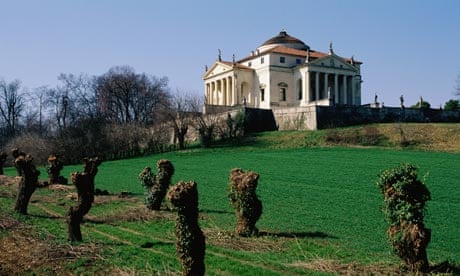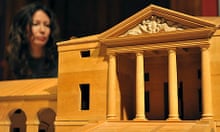One way or another, most of us have encountered Andrea Palladio. His presence has been, and remains, quietly insistent in our daily lives - even though this great Italian architect was born 500 years ago, almost to the day, and his working life was spent in a relatively contained landscape between his birthplace, Padua, and the scene of some of his greatest triumphs, Venice.
Every building Palladio designed, from a simple farmhouse to his grand monastic churches such as San Giorgio Maggiore in Venice, was a gem. Designed inside and out according to a sophisticated play of perfect geometry, each one remains an ideal to live up to. Handsomely crafted, imaginatively sited and bringing the best of classical Roman architecture up to date, his buildings had a profound influence on architecture worldwide.
Such was the compelling nature of their design that, after Palladio's death in 1580, British architects began to create buildings - from modest working-class terraces to magisterial country houses, along with town halls, assembly rooms, churches, inns, farmhouses and follies - that owe the essentials of their design, their proportions and much of their architectural spirit to the one-time Paduan stonecutter destined to become one of the greatest architects of all time.
What drew the Palladians, as these young British architects came to be known, to the master's work was its crystal-clear design, free of the pomp and theatrical circumstance of those architectural styles, especially the lavish baroque that came before an 18th-century revival of Palladianism. Here were classical buildings that seemed ideal for 18th-century, protestant Britain. Palladio showed how it was possible to shape a form of architecture that seemed almost timeless. Informed by mathematical logic, it was highly practical, rich in terms of its ideas, and lacked any over-elaborate decoration. No wonder the brightest British Modern movement architects of the 1930s were as in awe of Palladio as they were of Le Corbusier. They saw him, if not altogether correctly, as a kind of proto-Modern.
The work of the Palladians - spearheaded by the Anglo-Irish Earl of Burlington and Colen Campbell, a Scot - became the dominant force in British architecture. They in turn influenced the work of American architects, and by the mid-19th century, examples of Palladian design could be found around the globe, from St Petersburg to Cape Province. Even today, there are architects, notably the father and son team Quinlan and Francis Terry, who continue to work in a tradition descended from Palladio. In fact, the Terrys attract controversy precisely because they insist on pursuing a line of Palladianism, in the design of numerous country houses, as well as major urban shopping and office developments - as if the days of Palladio, or at least his ideals, were still part, parcel and pediment of everyday life.
This month, Palladio's life, work and legacy will be celebrated at the Royal Academy, London, a much rebuilt venue that was once Burlington House, a fine Piccadilly mansion remodelled by Campbell when Palladianism began to oust the English baroque style developed by Christopher Wren. The show, bringing Palladio to a 21st-century audience, will be a feast of drawings, models, photographs and paintings by Old Masters proving that the spirit, if not the exact forms, of purist classical architecture is still relevant today. The exhibition is on tour, having started life last autumn in Palladio's Palazzo Barbaran da Porto in the heart of Vicenza, the northern city he did so much to make his own, with his wonderful buildings lining its streets.
Portraits of Palladio's clients by Tintoretto, Titian and Veronese will be accompanied by original editions of the books Palladio wrote and illustrated, in particular The Four Books of Architecture, his monumentally influential work first published in 1570. Copies of it were reproduced across Europe, the US and beyond in ever cheaper and more available editions. Still readily available, it was The Four Books that arguably did most to spread Palladio's crisp, classical style. He was certainly a great communicator, his writing style echoing his solid, unshowy architectural philosophy. "I will avoid lengthy words," he wrote, "and will make use of those terms which workers commonly use today."
What was it, though, that has drawn so many to Palladio, from Italy, Britain, the US and even, in the 21st century, China? In clinical terms, the answer is that he offered a practical, perfectly proportioned, unpretentious form of classical design that could be pressed into elegant service for many different types of buildings. But the answer chiefly lies within the experience of the buildings themselves. Palladio transformed pure geometry into gracious, useful buildings in carefully considered settings. Stand in a room by Palladio - any formal room will do - and you will experience the feeling, both calming and elevating, of being centred not just in architectural space, but in yourself.
Recently, I stayed in Palladio's Villa Saraceno, a farmhouse in north Italy now in the care of the Berkshire-based charity, the Landmark Trust. What struck me was just how easy it was to live here and how, during a prolonged rainy spell, it was no loss to be holed up in this quietly magnificent building that looks and feels like a Roman temple, despite being a pared-down, almost barn-like workaday farmhouse. With its combination of frescoed public rooms, airy bedrooms, vast kitchens and cavernous rooftop haylofts, it's as much an adventure as a home. And it is a building that clearly demonstrates how Palladio's work should never be confused with the prissy, uptight, oddly proportioned houses described as "palladian" that continue to be built by house-builders in Britain just because they feature sash windows and pediments.
Inside, Villa Saraceno was all commodity, firmness and delight, easily conforming to those three architectural essentials: well built, beautiful, with intelligent and practical use of space. Any number of 18th-century British houses share something of the special qualities of Villa Saraceno. Its echoes can be detected in the guise of grand, if austere, country seats such as Holkham Hall in Norfolk, and in the thousands of terrace houses that line the streets of Britain. Created in an age of ruthless commerce yet commonplace architectural grace, these are civilised, perfectly proportioned houses we have come to cherish.
Even Villa Capra - one of Palladio's most celebrated designs, with its four temple-like elevations overlooking the countryside around Vicenza, and designed as a salon for wealthy gentlemen to read, admire and discuss art, as well as dine well - has been reproduced several times, more or less successfully, in Britain, beginning with Campbell's high-domed Mereworth Castle in Kent.
This, quite simply, is Campbell's Villa Capra.
Although Palladio's tirelessly inventive buildings tell us much about this brilliant miller's son, who rose on the crest of a wave of inspired patronage, the man himself remains a rather distant figure. What we do know is that the young stonecutter Andrea di Pietro della Gondola was discovered at about the age of 30 by the poet, dramatist, diplomat and architectural patron Giangiorgio Trissino, who took his protege to Rome. There, the young man marvelled at, and drew, antique ruins, and adopted the name Palladio, probably after the angel Palladio, a divine fictional character who saved Italy.
We know, too, that Palladio was popular with local patrons, labourers and craftsmen. The Venetian nobility and clergy took to him, too. He was evidently an unpretentious fellow, marrying a carpenter's daughter and never buying a house. A spendthrift, he was never wealthy and his sons caused him much grief. One was a convicted murderer.
Even if his later buildings became more mannered and even a little baroque, Palladio was never as chaste a designer as his many disciples in Britain and elsewhere thought. He was, in effect, no Palladian. Many of his buildings, including Palazzo Thiene in Vicenza and Villa Barbaro at Maser, break the Palladians' rules of chasteness. Palladio was less concerned with a specific style than his many followers were; he was far more interested in a reinterpretation of ancient Roman architecture, the eternal notions of harmony and proportion, and the idea that buildings were a practical joy.
His last building, the Teatro Olimpico in Vicenza, with its magnificent stage-set revealing seven retreating city streets, each an optical illusion, was completed after Palladio's death. Still much in use, it seems an appropriate finale: Palladio was soon to be striding across the world's stage, his architecture a part of the everyday vocabulary of so many cities for ever in his debt.
Behind the apparent simplicity of Palladio's designs is a complex architectural chemistry, beautifully resolved through an innate understanding of proportion and highly crafted and immensely practical building skills. Hopefully, the buildings Palladio built and inspired will continue to serve - and delight - us for the next 500 years and more.
Andrea Palladio: His Life and Legacy is at the Royal Academy, London W1, 31 January to 13 April. Details: 020-7300 8000 and royalacademy.org.uk



